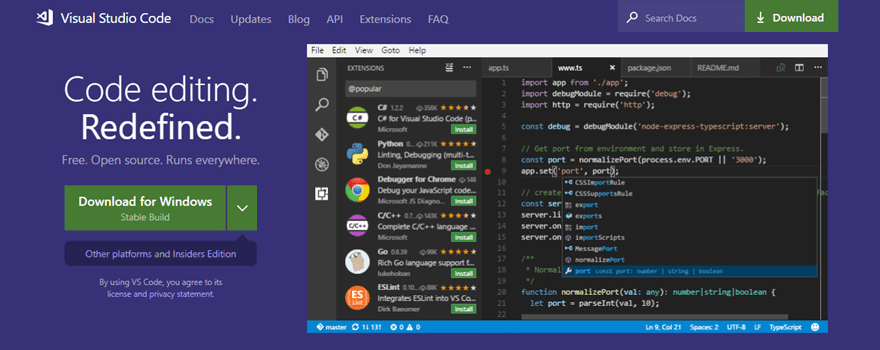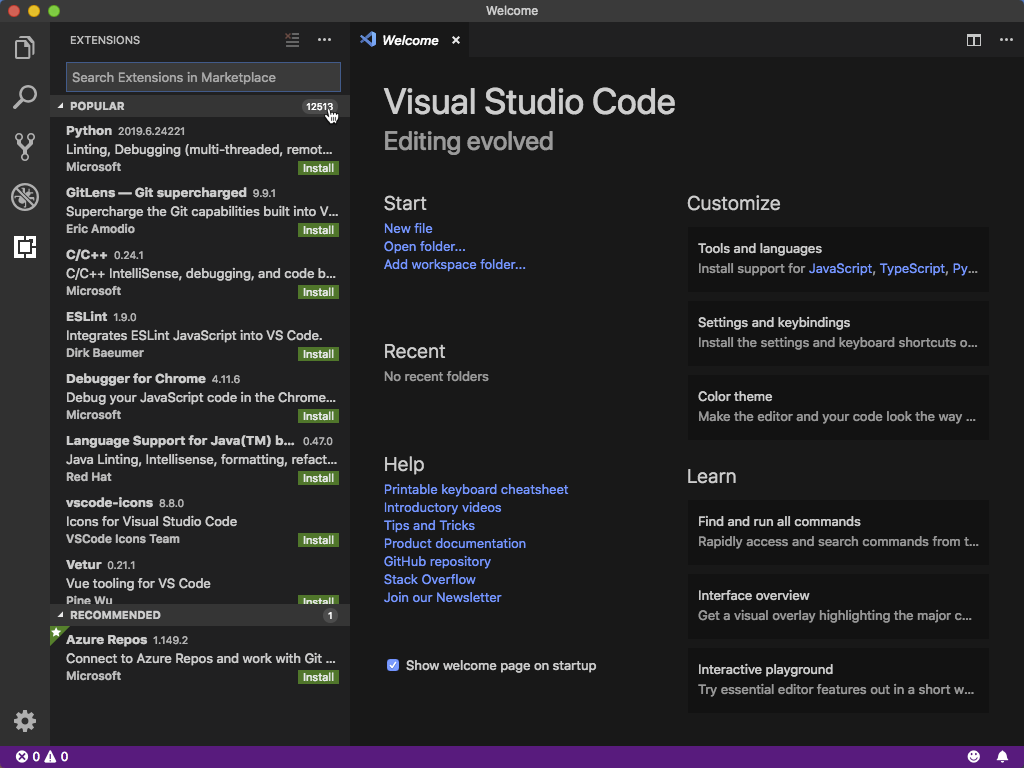Microsoft Visual Studio Code On Mac
The source editor provides features that you might expect and need to do your work with ease: From the basics such a syntax highlighting, code snippets, and code folding, to the benefits of its Roslyn compiler integration, such as fully functional IntelliSense code completion. The source editor in Visual Studio for Mac allows for a seamless.
- Visual Studio dev tools & services make app development easy for any platform & language. Try our Mac & Windows code editor, IDE, or Azure DevOps for free.
- Oct 30, 2019 Visual Studio for Mac is a macOS-native.NET IDE that focuses on.NET Core, Xamarin, and Unity. It provides many of the same features as Visual Studio for Windows, such as a shared C#, XAML, and web editor. For more information on Visual Studio for Mac, see our documentation. Before writing any code, you’ll first need to.
Install Microsoft Visual Studio Code On Mac
Latest Version:
Visual Studio Code 1.43.2 LATEST
Requirements:
Mac OS X 10.11 or later
Author / Product:
Microsoft Corporation / Visual Studio Code for Mac
Old Versions:
Filename:
VSCode-darwin-stable.zip
Details:
Visual Studio Code for Mac 2020 full offline installer setup for Mac
At its heart, Visual Studio Code for macOS features a powerful, fast code editor great for day-to-day use. The Preview release of Code already has many of the features developers need in a code and text editor, including navigation, keyboard support with customizable bindings, syntax highlighting, bracket matching, auto indentation, and snippets, with support for dozens of languages.
Meet IntelliSense
Go beyond syntax highlighting and autocomplete with IntelliSense, which provides smart completions based on variable types, function definitions, and imported modules.
Print statement debugging is a thing of the past
Debug code right from the editor. Launch or attach to your running apps and debug with break points, call stacks, and an interactive console.
Git commands built-in
Working with Git has never been easier. Review diffs, stage files, and make commits right from the editor. Push and pull from any hosted Git service.
Extensible and customizable
Want even more features? Install extensions to add new languages, themes, debuggers, and to connect to additional services. Extensions run in separate processes, ensuring they won't slow down your editor.
Note: Requires 64-bit processor.
Also Available: Download Visual Studio Code for Windows
Visual Studio for Mac can be customized, allowing users to develop apps in an environment that meets their needs for both efficiency and aesthetics. This article explores the variety of ways that Visual Studio for Mac can be adapted to suit your needs.
Dark theme
You can switch themes in Visual Studio for Mac by browsing to Visual Studio > Preferences > Environment > Visual Style and selecting your desired theme from the User Interface Theme drop-down, as illustrated in the following image:
Localization
Visual Studio for Mac is localized in the following 14 languages, enabling it to be accessible to more developers:
- Chinese - China
- Chinese - Taiwan
- Czech
- French
- German
- English
- Italian
- Japanese
- Korean
- Polish
- Portuguese - Brazil
- Russian
- Spanish
- Turkish
To change the language displayed by Visual Studio for Mac, browse to Visual Studio > Preferences > Environment > Visual Style and select your desired language from the User Interface Language drop-down, as illustrated in the following image:
Author information
The author information panel allows you to add relevant information about yourself such as your name, email address, the copyright owner for your work, your company, and trademark:

This information is used to populate standard file headers, such as a license, that you might add to new files:
Populated Name and Email fields will be used in any commit that is made through Version Control in Visual Studio for Mac. If you haven't populated these fields, Visual Studio for Mac will prompt you to do so when you try to use Version Control.
Key bindings
Key bindings, or keyboard shortcuts, allow you to adapt your development environment so that you can move more efficiently throughout Visual Studio for Mac. It provides familiar key bindings for many popular IDEs, such as Visual Studio (on Windows), ReSharper, Visual Studio Code, and Xcode.
Key bindings can be set by browsing to Visual Studio > Preferences > Environment > Key Bindings, as illustrated by the following image:
From here you can search for key binding combinations, view conflicting bindings, add new bindings, and edit the existing bindings.
These bindings can also be set during the initial setup of Visual Studio for Mac, via the Keyboard Selection screen:
Workspace layout
Visual Studio for Mac's workspace consists of a main document area (normally the editor, designer surface, or options file), surrounded by complimentary pads that contain useful information for accessing and managing application files, testing, and debugging.
How To Install Visual Studio Code On Mac
Viewing and arranging pads

When you open any new solution or file in Visual Studio for Mac, you should notice some pads in the workspace, including the Solution Pad, Document Outline, and Errors:
Visual Studio for Mac provides pads containing additional information, tools, and navigation aids, all of which can be accessed by browsing to the View > Pads menu item and selecting a pad to add it:
Pads may also be opened automatically by various commands, such as the Find in Files (Shift + Cmd + F) command, which opens a detached pad of search results.
Pads can be moved and arranged throughout your workflow in whatever way is most useful to you. For example, they can be docked on any side of the document editor, adjacent to another pad, above or below another pad, or as a set of tabbed pads enabling you to quickly switch between them.
For frequently used pads, you can also completely detach a pad from the Visual Studio for Mac window, and create a separate window for that pad.
Pads can be hidden and closed by the toggles in the top-right corner of each pad:
Autohidden pads are docked to the sides of the workspace making them easily accessible when they are required. Hovering over the pad displays it again, and it will be hidden when the mouse and keyboard focus leaves it.
Microsoft Visual Studio Downloads
Organizing layouts
The pads that are displayed at any time are dependent on the current context. For example, when using the visual designer, the toolbox and property grid pads are most important; when debugging, it is useful to have the debugger pads for viewing the stack and locals.
The state of the open pads is represented by a layout. The layouts can be switched manually through the View menu, as illustrated in the following image, or it is switched automatically when you carry out an action, such as debugging, or opening a Storyboard:
There is always one active layout and any change you make in a layout, such as adding or repositioning a pad, will only change the active layout. Once you close Visual Studio for Mac, the changes you have made will not be saved.
However, it is possible to create a new layout by using the View > Save Current Layout menu item. This command will add your current layout to the menu so that you can select it at any time:
Side-by-side editing support
Visual Studio for Mac allows you to open text editors side by side, or to have an editor as a detached floating window.
Two-column mode can be enabled through the View menu item by selecting View > Editor Columns > 2 columns, or by dragging an editor tab to one of the edges of the editor area:
Editor tabs can be dragged out of the document area to create a floating editor window. This floating window also supports side-by-side editors, and can contain several editor tabs:
To revert to a single open editor, select View > Editor Columns > 1 column.
Using Visual Studio On Mac
Related Video
